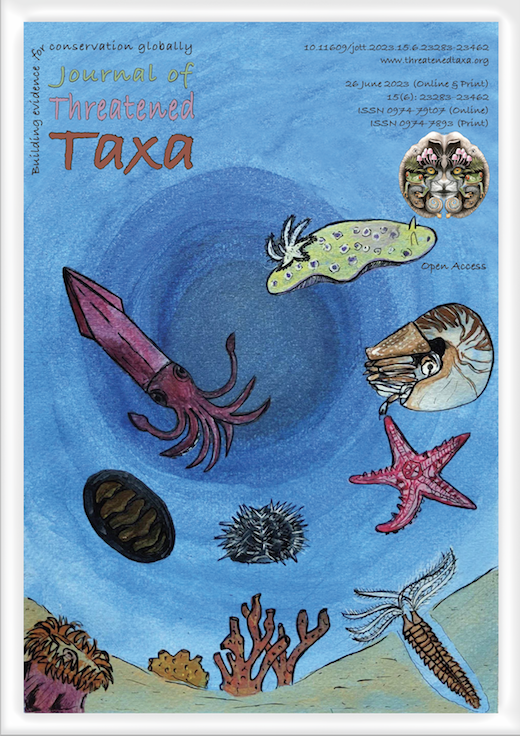New record of Lucilia cuprina (Wiedemann, 1830) (Diptera: Calliphoridae) from the Trans-Himalayan Region, cold arid desert of Kargil Ladakh, India
DOI:
https://doi.org/10.11609/jott.8312.15.6.23431-23435Keywords:
Green bottle fly, medically important, forensic important, veterinary importantAbstract
Lucilia spp. commonly known as the green bottle fly, is cosmopolitan in distribution and well documented from different parts of the world. They have medical, forensic and veterinary importance. In the present study, Lucilia cuprina (Wiedemann 1830) is documented for the first time from the Trans-Himalayan region of Kargil Ladakh. It was found that this fly is fairly widespread in the study area. These flies show strong positive correlation with the temperature and weak positive correlation with the relative humidity. Therefore, fly abundance was recorded maximum in midsummer (July & August) and least in April & October; however, no fly activity was seen during winter months from November through March.
References
Akbarzadeh, K., J.F. Wallman, H. Sulakova & K. Szpila (2015). Species identification of Middle Eastern blowflies (Diptera: Calliphoridae) of forensic importance. Parasitology Research 114: 1463–1472.
Behera, M.D., S. Matin & P.S. Roy (2014). Biodiversity of Kargil cold desert in the Ladakh Himalaya, pp. 253–274. In: Nakano, S.I., T. Yahara & T. Nakashizuka (eds.). Integrative Observations and Assessments. Ecological Research Monographs. Springer, Tokyo, 431 pp. https://doi.org/10.1007/978-4-431-54783-9_13
Bharti, M. (2011). An updated checklist of blowflies (Diptera: Calliphoridae) from India. Halteres 3: 34–37.
Brundage, A., S. Bros & J.Y. Honda (2011). Seasonal and habitat abundance and distribution of some forensically important blow flies (Diptera: Calliphoridae) in Central California. Forensic Science International 212(1–3): 115–120.
Carvalho, C.J.B. de & C.A. de Mello-Patiu (2008). Key to the adults of the most common forensic species of Diptera in South America. Revista Brasileira de Entomologia 52: 390–406.
Falk, S. (2016). British blow flies (Calliphoridae) and woodlouse flies (Rhinophoridae). Draft Key to British Calliphoridae and Rhinophoridae 1–86.
Fetene, T. & N. Worku (2009). Public health importance of non-biting cyclorrhaphan flies. Transactions of the Royal Society of Tropical Medicine and Hygiene 103(2): 187–191.
Hasson, R.H. (2017). Prevalence of medical and veterinary important Dipterans flies in Diyala province-Iraq. AL-Qadisiyah Journal of Veterinary Medicine Sciences 15(2): 108–114.
Heath, A.C.G. (1982). Beneficial aspects of blowflies (Diptera: Calliphoridae). New Zealand Entomologist 7(3): 343–348.
Hussain, M., A.H. Mir & H. Tak (2022). New record of Protophormia sp.(Calliphoridae: Diptera) from cold arid desert Kargil Ladakh. Indian Journal of Entomology 84(3): 611–613.
Hussain, M., A.H. Mir, H. Tak & N.F. Kacho (2022). New Record of Lucilia sericata (Wiedemann) From Kargil Ladakh. Indian Journal of Entomology 85(1): 178–180.
Nandi, B.C. (2002). Blow flies (Diptera: Calliphoridae) of West Bengal, India with a note on their biodiversity. Records of the Zoological Survey of India 100(1–2): 117–129.
Nandi, B.C. & S.K. Sinha (2004). On a small collection of muscid flies (Diptera: Muscidae) of Sundarbans Biosphere Reserve, India. Records of the Zoological Survey of India 102(1–2): 11–26.
Rosati, J.Y. (2014). Spatial and temporal variability in the carrion insect community: using blow flies (Family: Calliphoridae) as a model system to study coexistence mechanisms at multiple scales. University of Windsor 227 pp.
Stevens, J. & R. Wall (1996). Species, sub-species and hybrid populations of the blowflies Lucilia cuprina and Lucilia sericata (Diptera: Calliphoridae). Proceedings of the Royal Society of London. Series B: Biological Sciences 263(1375): 1335–1341.
Tomberlin, J.K., T.L. Crippen, A.M. Tarone, M.F. Chaudhury, B. Singh, J.A. Cammack & R.P. Meisel (2017). A review of bacterial interactions with blow flies (Diptera: Calliphoridae) of medical, veterinary, and forensic importance. Annals of the Entomological Society of America 110(1): 19–36.
Wall, R., N.P. French & A. Fenton (2000). Sheep blowfly strike: a model approach. Research in Veterinary Science 69(1): 1–9.
Wallman, J.F. (2001). A key to the adults of species of blowflies in southern Australia known or suspected to breed in carrion. Medical and Veterinary Entomology 15(4): 433–437.
Whitmore, D., S. Dupont & S. Falk (2020). Key to adult flesh flies (Diptera: Sarcophagidae) of the British Isles. OSF Preprints 2020 1–58. https://doi.org/10.31219/osf.io/vf5r6
Published
Versions
- 26-06-2023 (2)
- 26-06-2023 (1)
Issue
Section
License
Copyright (c) 2023 Mohd Hussain, Altaf Hussain Mir, Hidayatullah Tak, Nassreen Fatima Kacho

This work is licensed under a Creative Commons Attribution 4.0 International License.
Authors own the copyright to the articles published in JoTT. This is indicated explicitly in each publication. The authors grant permission to the publisher Wildlife Information Liaison Development (WILD) Society to publish the article in the Journal of Threatened Taxa. The authors recognize WILD as the original publisher, and to sell hard copies of the Journal and article to any buyer. JoTT is registered under the Creative Commons Attribution 4.0 International License (CC BY), which allows authors to retain copyright ownership. Under this license the authors allow anyone to download, cite, use the data, modify, reprint, copy and distribute provided the authors and source of publication are credited through appropriate citations (e.g., Son et al. (2016). Bats (Mammalia: Chiroptera) of the southeastern Truong Son Mountains, Quang Ngai Province, Vietnam. Journal of Threatened Taxa 8(7): 8953–8969. https://doi.org/10.11609/jott.2785.8.7.8953-8969). Users of the data do not require specific permission from the authors or the publisher.





